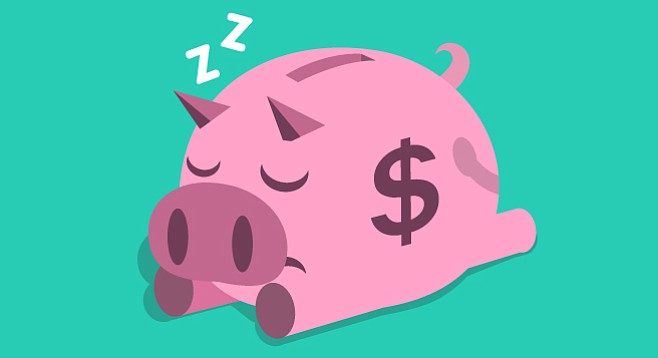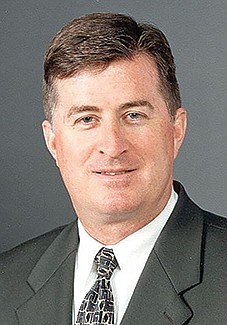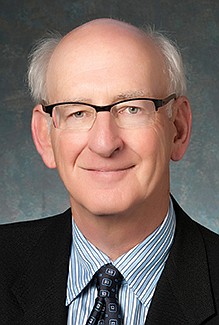 Facebook
Facebook
 X
X
 Instagram
Instagram
 TikTok
TikTok
 Youtube
Youtube

Economic forecasters are befuddled. Will President Trump ignite destructive trade wars? Or will a crackdown on companies shipping jobs overseas jack up employment and stimulate the economy? Will his planned massive tax cuts thrust the economy forward or inflate the deficit so severely that interest rates soar? Will slashing regulation liberate business or generate greed and stupid decision-making that lead to another crash?
Will the economy soar from the stimuli or plunge into recession because of high interest rates?
There is a boring possibility: the economy — in the nation and in San Diego County — will be sluggish and unexciting, just as it has been since 2007.
Kelly Cunningham, economist for the National University System, says that San Diego County’s total output of goods and services (the regional gross domestic product) will lag next year. The nation’s inflation-adjusted growth will slow to 1.4 percent and San Diego will only come up with 1.2 percent, trailing the state’s 1.7 percent.
Defense spending, which is a bit below 20 percent of the local economy, “has been declining the last three or four years. Trump has talked about more military spending, but I don’t know how fast it will ripple through the economy,” says Cunningham. And it may be a while before any increased military spending is cranked up.

Real estate is about 20 percent of the economy, and the picture is mixed. San Diego housing is among the least affordable in the nation. The median price of a San Diego home is now $500,000, a return to the level of 2006. Today, a San Diegan has to have an income of $108,654 to buy a median-priced home, according to HSH.com, which puts the median home value at a higher $589,300. But median household income in the county was $67,320 last year. And San Diego’s cost of living is 45.7 percent higher than the nation’s. Locals call moderate incomes and high living costs “the sunshine tax,” and it may worsen next year.

Inflation-adjusted household income “has been down for 20 years and will rise slowly,” says Cunningham. “The year 2007 was the high point for [inflation-adjusted] median household income, and we’re still below that and still below the year 2000.”
Technology is 10 percent of local jobs and 20 percent of payroll, because pay is twice as high as in other sectors. Tech should continue doing well, says Cunningham, but he does fear a recession, brought on by higher interest rates. Next year will be the eighth since the end of the Great Recession and the tenth since the beginning of it. San Diego has “never gone beyond ten years” without a recession coming along, he says.
San Diego’s median household income last year of $67,320 tops the nation’s $55,775 but only squeaks past California’s $64,500. One reason is the state’s money machine: Silicon Valley. Its median household income last year was $101,980.

San Diegans boast that posh places like Rancho Santa Fe and Del Mar are proof of the county’s ability to generate income. Those towns have, respectively, median household incomes of $101,250 and $103,457.
But look at the median household incomes in towns within Santa Clara County, which embraces the bulk of Silicon Valley: Cupertino, $134,872; Saratoga, $167,917; Los Altos, $157,500; and (gulp) Los Altos Hills, $224,271.
Conclusion: tech pays. San Diego needs more of it.

According to Peter Brownell, research director of the Center on Policy Initiatives, 15.6 percent of City of San Diego residents live below the poverty line. However, “we will be ahead of the state in minimum wage,” he says. On January 1, 2017, the city will go to $11.50 and the state (for larger businesses) will go to $10.50.
“Throughout 2017, depending on the size of the business, San Diego will be $1 to $1.50 ahead of the state” in minimum wage, and at least 170,000 people in the city will enjoy that, adding more purchasing power and bolstering the local economy, Brownell says.
Opponents claim the raised minimum wage kills jobs. Brownell disputes that. “Since July, when the city’s minimum wage went up 50 cents, the county added 18,500 jobs. The city accounts for over 60 percent of jobs in the county,” he says. He realizes that there were other factors in the employment increase.
Tourism may be pretty flat in 2017. According to Smith Travel Research, local hotel occupancy has been 78.8 percent through October, up a hair from 78.6 percent for the same period last year. Hotel consultant Jerry Morrison predicts it will creep up to only 79 percent in 2017. “This has not been a wonderful year, and unless there is a big turnaround, I don’t see next year being a heck of a lot better,” says Morrison.
Los Angeles has made some big hotel gains resulting from its spiffying up of the downtown area, and these gains may continue, says Morrison. San Francisco’s average daily room rate through October was $237.62, second only to New York’s $253.28. San Diego’s room rates through the same period were a much lower $157.62.
“Las Vegas is going to eat everybody’s lunch,” says Morrison. Its hotel tax “all goes to promote tourism. More and more people are coming. There is so much convention space. The convention-center rates are still lower than ours.” And, of course, it has a very descriptive and seductive nickname: Sin City.
What about investing? Some analysts think stock and bond prices are very high, and with the economy possibly sagging, the stock market is running out of gas. But Mike Stolper of San Diego’s Stolper & Company sees Donald Trump as a reason to buy stocks.
“Whether you love him or hate him, he is creating the most benevolent business environment since the Eisenhower years,” says Stolper. “We are likely to see more favorable corporate tax rates, less regulation, fewer environmental obstacles — accelerated economic growth and a laissez faire environment.” That will be good for stocks. Higher interest rates won’t interfere with stocks but will hit bonds, thus steering some money to stocks. “We’re not talking 30 or 40 percent gains, but a good year.”


Economic forecasters are befuddled. Will President Trump ignite destructive trade wars? Or will a crackdown on companies shipping jobs overseas jack up employment and stimulate the economy? Will his planned massive tax cuts thrust the economy forward or inflate the deficit so severely that interest rates soar? Will slashing regulation liberate business or generate greed and stupid decision-making that lead to another crash?
Will the economy soar from the stimuli or plunge into recession because of high interest rates?
There is a boring possibility: the economy — in the nation and in San Diego County — will be sluggish and unexciting, just as it has been since 2007.
Kelly Cunningham, economist for the National University System, says that San Diego County’s total output of goods and services (the regional gross domestic product) will lag next year. The nation’s inflation-adjusted growth will slow to 1.4 percent and San Diego will only come up with 1.2 percent, trailing the state’s 1.7 percent.
Defense spending, which is a bit below 20 percent of the local economy, “has been declining the last three or four years. Trump has talked about more military spending, but I don’t know how fast it will ripple through the economy,” says Cunningham. And it may be a while before any increased military spending is cranked up.

Real estate is about 20 percent of the economy, and the picture is mixed. San Diego housing is among the least affordable in the nation. The median price of a San Diego home is now $500,000, a return to the level of 2006. Today, a San Diegan has to have an income of $108,654 to buy a median-priced home, according to HSH.com, which puts the median home value at a higher $589,300. But median household income in the county was $67,320 last year. And San Diego’s cost of living is 45.7 percent higher than the nation’s. Locals call moderate incomes and high living costs “the sunshine tax,” and it may worsen next year.

Inflation-adjusted household income “has been down for 20 years and will rise slowly,” says Cunningham. “The year 2007 was the high point for [inflation-adjusted] median household income, and we’re still below that and still below the year 2000.”
Technology is 10 percent of local jobs and 20 percent of payroll, because pay is twice as high as in other sectors. Tech should continue doing well, says Cunningham, but he does fear a recession, brought on by higher interest rates. Next year will be the eighth since the end of the Great Recession and the tenth since the beginning of it. San Diego has “never gone beyond ten years” without a recession coming along, he says.
San Diego’s median household income last year of $67,320 tops the nation’s $55,775 but only squeaks past California’s $64,500. One reason is the state’s money machine: Silicon Valley. Its median household income last year was $101,980.

San Diegans boast that posh places like Rancho Santa Fe and Del Mar are proof of the county’s ability to generate income. Those towns have, respectively, median household incomes of $101,250 and $103,457.
But look at the median household incomes in towns within Santa Clara County, which embraces the bulk of Silicon Valley: Cupertino, $134,872; Saratoga, $167,917; Los Altos, $157,500; and (gulp) Los Altos Hills, $224,271.
Conclusion: tech pays. San Diego needs more of it.

According to Peter Brownell, research director of the Center on Policy Initiatives, 15.6 percent of City of San Diego residents live below the poverty line. However, “we will be ahead of the state in minimum wage,” he says. On January 1, 2017, the city will go to $11.50 and the state (for larger businesses) will go to $10.50.
“Throughout 2017, depending on the size of the business, San Diego will be $1 to $1.50 ahead of the state” in minimum wage, and at least 170,000 people in the city will enjoy that, adding more purchasing power and bolstering the local economy, Brownell says.
Opponents claim the raised minimum wage kills jobs. Brownell disputes that. “Since July, when the city’s minimum wage went up 50 cents, the county added 18,500 jobs. The city accounts for over 60 percent of jobs in the county,” he says. He realizes that there were other factors in the employment increase.
Tourism may be pretty flat in 2017. According to Smith Travel Research, local hotel occupancy has been 78.8 percent through October, up a hair from 78.6 percent for the same period last year. Hotel consultant Jerry Morrison predicts it will creep up to only 79 percent in 2017. “This has not been a wonderful year, and unless there is a big turnaround, I don’t see next year being a heck of a lot better,” says Morrison.
Los Angeles has made some big hotel gains resulting from its spiffying up of the downtown area, and these gains may continue, says Morrison. San Francisco’s average daily room rate through October was $237.62, second only to New York’s $253.28. San Diego’s room rates through the same period were a much lower $157.62.
“Las Vegas is going to eat everybody’s lunch,” says Morrison. Its hotel tax “all goes to promote tourism. More and more people are coming. There is so much convention space. The convention-center rates are still lower than ours.” And, of course, it has a very descriptive and seductive nickname: Sin City.
What about investing? Some analysts think stock and bond prices are very high, and with the economy possibly sagging, the stock market is running out of gas. But Mike Stolper of San Diego’s Stolper & Company sees Donald Trump as a reason to buy stocks.
“Whether you love him or hate him, he is creating the most benevolent business environment since the Eisenhower years,” says Stolper. “We are likely to see more favorable corporate tax rates, less regulation, fewer environmental obstacles — accelerated economic growth and a laissez faire environment.” That will be good for stocks. Higher interest rates won’t interfere with stocks but will hit bonds, thus steering some money to stocks. “We’re not talking 30 or 40 percent gains, but a good year.”
Comments